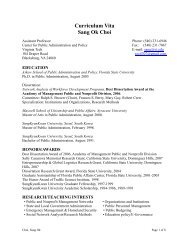1 Towards a Critical Social Theory of Philanthropy in an Era of ...
1 Towards a Critical Social Theory of Philanthropy in an Era of ...
1 Towards a Critical Social Theory of Philanthropy in an Era of ...
Create successful ePaper yourself
Turn your PDF publications into a flip-book with our unique Google optimized e-Paper software.
<strong>Towards</strong> a <strong>Critical</strong> <strong>Social</strong> <strong>Theory</strong> <strong>of</strong> <strong>Phil<strong>an</strong>thropy</strong> <strong>in</strong> <strong>an</strong> <strong>Era</strong> <strong>of</strong> Govern<strong>an</strong>ce<br />
Introduction<br />
Recent scholarship has observed a shift <strong>in</strong> political systems around the world from<br />
hierarchically org<strong>an</strong>ized, unitary systems <strong>of</strong> government to more horizontally org<strong>an</strong>ized <strong>an</strong>d<br />
relatively fragmented systems <strong>of</strong> govern<strong>an</strong>ce (Baccaro 2006; Hirst 2000; Pierre 2000; Rhodes<br />
1994; Sorensen 2002; Sorensen & Torf<strong>in</strong>g 2005). Govern<strong>an</strong>ce generally refers to a system <strong>in</strong><br />
which the state becomes one <strong>of</strong> m<strong>an</strong>y authorities or players, along with extra-state <strong>in</strong>stitutions,<br />
with<strong>in</strong> a given policy area. With<strong>in</strong> the context <strong>of</strong> govern<strong>an</strong>ce, there is a grow<strong>in</strong>g expectation <strong>an</strong>d<br />
preference for non-governmental action to act as a me<strong>an</strong>s to solve societal problems.<br />
Phil<strong>an</strong>thropists <strong>an</strong>d the org<strong>an</strong>izations they fund are becom<strong>in</strong>g key players <strong>in</strong> the shift from the<br />
welfare state to govern<strong>an</strong>ce. Wealthy <strong>in</strong>dividuals like Bill <strong>an</strong>d Mel<strong>in</strong>da Gates <strong>an</strong>d George Soros<br />
have the drive <strong>an</strong>d wherewithal to impact public policy on a global scale (Byrne 2002; Zizek<br />
2006; The Economist 2004, 2006a, 2006b, 2006c, 2006d). 1<br />
There is reason for concern when we discuss govern<strong>an</strong>ce <strong>an</strong>d its reli<strong>an</strong>ce on phil<strong>an</strong>thropy<br />
as be<strong>in</strong>g <strong>in</strong>evitable <strong>an</strong>d without consider<strong>in</strong>g what these labels represent. The question <strong>of</strong> what<br />
govern<strong>an</strong>ce me<strong>an</strong>s, both theoretically <strong>an</strong>d <strong>in</strong> practice, is still be<strong>in</strong>g debated (Pierre 2000). We<br />
seek to contribute to this discussion through <strong>an</strong> <strong>an</strong>alysis <strong>of</strong> govern<strong>an</strong>ce <strong>an</strong>d social policy with a<br />
specific focus on phil<strong>an</strong>thropy. In this chapter we explore the role <strong>of</strong> phil<strong>an</strong>thropy as social<br />
policy <strong>in</strong> <strong>an</strong> era <strong>of</strong> govern<strong>an</strong>ce through the lens <strong>of</strong> critical social theory. Our argument is that we<br />
should not focus solely on the delivery mech<strong>an</strong>ism for social policy without discuss<strong>in</strong>g what<br />
1 <strong>Phil<strong>an</strong>thropy</strong>’s me<strong>an</strong><strong>in</strong>g <strong>an</strong>d m<strong>an</strong>ifestations have ch<strong>an</strong>ged throughout history (Curti 1973); however, <strong>in</strong> recent<br />
years it has come to be def<strong>in</strong>ed as the act <strong>of</strong> giv<strong>in</strong>g money <strong>an</strong>d other resources, <strong>in</strong>clud<strong>in</strong>g time, to aid <strong>in</strong>dividuals,<br />
causes, <strong>an</strong>d charitable org<strong>an</strong>izations (<strong>Phil<strong>an</strong>thropy</strong> 2000). We argue elsewhere that it also disguises its own<br />
discourse <strong>in</strong> its portrayal <strong>of</strong> the mediums <strong>of</strong> consumption, pr<strong>of</strong>it, <strong>an</strong>d media celebration as the basis for benevolent<br />
hum<strong>an</strong> relations (Nickel & Eikenberry 2006).<br />
3






